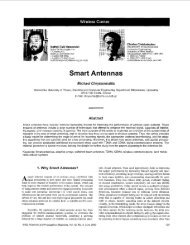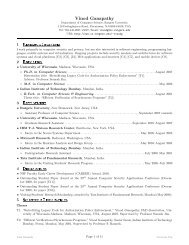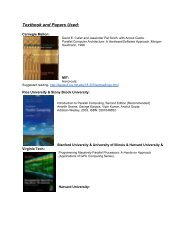Chapter 6: Bayesian Learning (Part 2) Bayesian Learning Naïve ...
Chapter 6: Bayesian Learning (Part 2) Bayesian Learning Naïve ...
Chapter 6: Bayesian Learning (Part 2) Bayesian Learning Naïve ...
Create successful ePaper yourself
Turn your PDF publications into a flip-book with our unique Google optimized e-Paper software.
<strong>Chapter</strong> 6:<br />
<strong>Bayesian</strong> <strong>Learning</strong> (<strong>Part</strong> 2)<br />
CS 536: Machine <strong>Learning</strong><br />
Littman (Wu, TA)<br />
<strong>Naïve</strong> Bayes Classifier<br />
Along with decision trees, neural networks, kNN,<br />
one of the most practical and most used<br />
learning methods.<br />
When to use:<br />
• Moderate or large training set available<br />
• Attributes that describe instances are<br />
conditionally independent given classification<br />
Successful applications:<br />
• Diagnosis<br />
• Classifying text documents<br />
<strong>Bayesian</strong> <strong>Learning</strong><br />
[Read Ch. 6, except 6.3]<br />
[Suggested exercises: 6.1, 6.2, 6.6]<br />
• Bayes Theorem<br />
• MAP, ML hypotheses<br />
• MAP learners<br />
• Minimum description length principle<br />
• Bayes optimal classier<br />
• <strong>Naïve</strong> Bayes learner (today)<br />
• Example: <strong>Learning</strong> over text data (today)<br />
• <strong>Bayesian</strong> belief networks (skim)<br />
• Expectation Maximization algorithm (later)<br />
<strong>Naïve</strong> Bayes Classifier<br />
Assume target function f : X ! V,<br />
where each instance x described by<br />
attributes .<br />
Most probable value of f (x) is:<br />
v MAP = argmax vj in V P(v j|a 1, a 2 … a n)<br />
= argmax vj in V P(a 1, a 2 … a n, |v j) P(v j ) /<br />
P(a 1, a 2 … a n)<br />
= argmax vj in V P(a 1, a 2 … a n, |v j) P(v j )
<strong>Naïve</strong> Bayes Assumption<br />
P(a 1, a 2 … a n, |v j ) = # i P(a i |v j ),<br />
which gives<br />
<strong>Naïve</strong> Bayes classifier:<br />
v NB = argmax vj in V P(v j ) # i P(a i |v j )<br />
Note: No search in training!<br />
<strong>Naïve</strong> Bayes: Example<br />
• Consider PlayTennis again, and new<br />
instance<br />
<br />
Want to compute:<br />
v NB = argmax vj in V P(v j) # i P(a i |v j)<br />
P(y) P(sun|y) P(cool|y) P(high|y) P(strong|y) = .005<br />
P(n) P(sun|n) P(cool|n) P(high|n) P(strong|n) = .021<br />
• So, v NB = n<br />
<strong>Naïve</strong> Bayes Algorithm<br />
<strong>Naïve</strong>_Bayes_Learn(examples)<br />
For each target value vj ^<br />
P(v j) " estimate P(v j)<br />
For each attribute value ai of each<br />
attribute a<br />
^<br />
P(ai|vj) " estimate P(ai|vj) Classify_New_Instance(x)<br />
^ ^<br />
vNB = argmaxvj in V P(vj) # i P(ai |vj) <strong>Naïve</strong> Bayes: Subtleties<br />
1. Conditional independence assumption is often<br />
violated<br />
P(a 1 , a 2 … a n, |v j ) = # i P(a i |v j )<br />
• ...but it works surprisingly well anyway. Note<br />
don't need estimated posteriors P(v j |x) to be<br />
correct; need only that<br />
argmax vj in V P(v j |a 1 , a 2 … a n )<br />
= argmax vj in V P(v j ) # i P(a i |v j )<br />
• Domingos & Pazzani [1996] for analysis<br />
• <strong>Naïve</strong> Bayes posteriors often unrealistically<br />
close to 1 or 0
<strong>Naïve</strong> Bayes: Subtleties<br />
2. What if none of the training instances with<br />
target value v j have attribute a i ?<br />
P(a i |v j ) = 0, and… P(v j ) # i P(a i |v j ) = 0<br />
Solution is <strong>Bayesian</strong> estimate:<br />
P(a i |v j ) = (n c + mp)/(n + m) where<br />
• n is number of training examples for which v = v j ,<br />
• n c number of examples for which v = v j and a = a i<br />
• p is prior estimate for P(a i |v j )<br />
• m is weight given to prior (i.e., number of “virtual”<br />
examples)<br />
<strong>Learning</strong> to Classify Text<br />
Target concept Interesting?: Document ! { +, - }<br />
1. Represent each document by vector of words<br />
• one attribute per word position in document<br />
2. <strong>Learning</strong>: Use training examples to estimate<br />
• P(+) P(-)<br />
• P(doc| +) P(doc| -)<br />
<strong>Learning</strong> to Classify Text<br />
Why?<br />
• Learn which news articles are of<br />
interest<br />
• Learn to classify web pages by<br />
topic<br />
<strong>Naïve</strong> Bayes is among most effective<br />
algorithms<br />
• What attributes shall we use to<br />
represent text documents??<br />
<strong>Naïve</strong> Bayes for Text<br />
• <strong>Naïve</strong> Bayes conditional<br />
independence assumption<br />
P(doc |v j) = # i=1 length(doc) P(ai =w k|v j)<br />
where P(a i =w k|v j) is probability that<br />
word in position i is w k, given v j<br />
One more assumption:<br />
• P(a i =w k|v j) = P(a m =w k|v j) $i, m<br />
“Bag of words” assumption.
<strong>Learning</strong> Algorithm<br />
LEARN_NAÏVE_BAYES_TEXT(Examples, V )<br />
1. collect all words and other tokens that occur in Examples<br />
• Vocabulary " all distinct words and other tokens in<br />
Examples<br />
2. Calculate the required P(v j ) and P(w k |v j ) probability terms<br />
• For each target value v j in V do<br />
– docs j " subset of Examples for which the target value is v j<br />
– P(v j ) " |docs j |/|Examples|<br />
– Text j " a single document created by concatenating all<br />
members of docs j<br />
– n " total number of words in Text j (counting duplicate words<br />
multiple times) (“tokens” vs. “tokens”)<br />
– for each word w k in Vocabulary<br />
• n k " number of times word w k occurs in Text j<br />
• P(w k |v j ) " (n k + 1) / (n + |Vocabulary|)<br />
Twenty NewsGroups<br />
Given 1000 training documents from each<br />
group, learn to classify new documents<br />
according to newsgroup:<br />
comp.graphics misc.forsale<br />
comp.os.ms-windows.misc rec.autos<br />
comp.sys.ibm.pc.hardware rec.motorcycles<br />
comp.sys.mac.hardware rec.sport.baseball<br />
comp.windows.x rec.sport.hockey<br />
alt.atheism sci.space<br />
soc.religion.christian sci.crypt<br />
talk.religion.misc sci.electronics<br />
talk.politics.mideast sci.med<br />
talk.politics.misc talk.politics.guns<br />
<strong>Naïve</strong> Bayes: 89% classification accuracy<br />
Classification Algorithm<br />
CLASSIFY_NAÏVE_BAYES_TEXT (Doc)<br />
• positions " all word positions in<br />
Doc that contain tokens found in<br />
Vocabulary<br />
• Return v NB, where<br />
v NB = argmax vj in V P(v j) # i in positions P(a i|v j)<br />
Article in rec.sport.hockey<br />
• Path: cantaloupe.srv.cs.cmu.edu!das-news.harvard.edu<br />
• From: xxx@yyy.zzz.edu (John Doe)<br />
• Subject: Re: This year's biggest and worst (opinion)<br />
• Date: 5 Apr 93 09:53:39 GMT<br />
I can only comment on the Kings, but the most<br />
obvious candidate for pleasant surprise is Alex<br />
Zhitnik. He came highly touted as a defensive<br />
defenseman, but he's clearly much more than that.<br />
Great skater and hard shot (though wish he were more<br />
accurate). In fact, he pretty much allowed the Kings<br />
to trade away that huge defensive liability Paul<br />
Coffey. Kelly Hrudey is only the biggest<br />
disappointment if you thought he was any good to<br />
begin with. But, at best, he's only a mediocre<br />
goaltender. A better choice would be Tomas<br />
Sandstrom, though not through any fault of his own,<br />
but because some thugs in Toronto decided
<strong>Learning</strong> Curve<br />
Accuracy vs. Training set size (1/3 withheld for test)<br />
Conditional Independence<br />
Definition: X is conditionally<br />
independent of Y given Z if the<br />
probability distribution governing X<br />
is independent of the value of Y<br />
given the value of Z; that is, if<br />
($ x i, y j, z k) P(X = x i|Y = y j, Z = z k)<br />
= P(X = x i|Z = z k)<br />
more compactly, we write<br />
P(X | Y, Z) = P(X | Z)<br />
<strong>Bayesian</strong> Belief Networks<br />
(Also called Bayes Nets, directed graphical<br />
models, BNs, …). Interesting because:<br />
• <strong>Naïve</strong> Bayes assumption of conditional<br />
independence too restrictive<br />
• But it's intractable without some such<br />
assumptions...<br />
• Belief networks describe conditional<br />
independence among subsets of<br />
variables<br />
! allows combining prior knowledge about<br />
(in)dependencies among variables with<br />
observed training data<br />
Independence Example<br />
Example: Thunder is conditionally<br />
independent of Storm, given Lightning<br />
P(Thunder | Storm, Lightning)<br />
= P(Thunder | Lightning)<br />
<strong>Naïve</strong> Bayes uses conditional ind. to justify<br />
P(X, Y | Z) = P(X |Y,Z) P(Y | Z)<br />
= P(X |Z) P(Y | Z)
<strong>Bayesian</strong> Belief Network<br />
Network represents a set of conditional ind. assertions:<br />
• Each node is asserted to be conditionally ind. of its<br />
nondescendants, given its immediate predecessors.<br />
• Directed acyclic graph<br />
Inference in <strong>Bayesian</strong> Nets<br />
How can one infer the (probabilities of)<br />
values of one or more network variables,<br />
given observed values of others?<br />
• Bayes net contains all information needed<br />
for this inference<br />
• If only one variable with unknown value,<br />
easy to infer it<br />
• Easy if BN is a “polytree”<br />
• In general case, problem is NP hard (#Pcomplete,<br />
Roth 1996).<br />
<strong>Bayesian</strong> Belief Network<br />
Represents joint probability distribution over all variables<br />
• e.g., P(Storm, BusTourGroup, …, ForestFire)<br />
• in general, P(y 1 ,…, y n ) = # i=1 n P(yi |Parents(Y i ))<br />
where Parents(Y i ) denotes immediate predecessors of Y i in graph<br />
• so, joint distribution is fully defined by graph, plus the<br />
P(y i |Parents(Y i )) (CPTs)<br />
Inference in Practice<br />
In practice, can succeed in many cases<br />
• Exact inference methods work well for<br />
some network structures (small “induced<br />
width”)<br />
• Variational methods good approximation<br />
if nodes tightly coupled<br />
• Monte Carlo methods “simulate” the<br />
network randomly to calculate<br />
approximate solutions<br />
Now used as a primitive in more advanced<br />
learning and reasoning scenarios.
<strong>Learning</strong> of <strong>Bayesian</strong> Nets<br />
Several variants of this learning task<br />
• Network structure might be known<br />
or unknown<br />
• Training examples might provide<br />
values of all network variables, or<br />
just some<br />
structure known unknown<br />
observe<br />
some all<br />
like <strong>Naïve</strong><br />
Bayes<br />
Gradient Ascent for BNs<br />
Let w ijk denote one entry in the conditional<br />
probability table for variable Y i in the<br />
network<br />
w ijk = P(Y i = y ij|Parents(Y i) = u ik values)<br />
e.g., if Y i = Campfire, then u ik might be<br />
<br />
Perform gradient ascent by repeatedly:<br />
1. Update all w ijk using training data D<br />
w ijk " w ijk + % & d in D P h(y ij, u ik|d)/w ijk<br />
2. Then, renormalize the w ijk to assure<br />
& j w ijk = 1, 0 ! w ijk ! 1<br />
<strong>Learning</strong> Bayes Nets<br />
Suppose structure known, variables<br />
partially observable<br />
e.g., observe ForestFire, Storm,<br />
BusTourGroup, Thunder, but not<br />
Lightning, Campfire...<br />
Similar to training neural network with<br />
hidden units<br />
• In fact, can learn network conditional<br />
probability tables using gradient ascent!<br />
• Converge to network h that (locally)<br />
maximizes P(D|h)<br />
More on <strong>Learning</strong> BNs<br />
EM algorithm can also be used.<br />
Repeatedly:<br />
1. Calculate probabilities of<br />
unobserved variables, assuming h<br />
2. Calculate new w ijk to maximize<br />
E [ln P(D|h)]<br />
where D now includes both observed<br />
and (calculated probabilities of)<br />
unobserved variables
Unknown Structure<br />
When structure unknown...<br />
• Algorithms use greedy search to<br />
add/subtract edges and nodes<br />
• Active research topic<br />
Somewhat like decision trees:<br />
searching for a discrete graph<br />
structure<br />
Expectation Maximization<br />
When to use EM:<br />
• Data is only partially observable<br />
• Unsupervised clustering (target value<br />
unobservable)<br />
• Supervised learning (some instance<br />
attributes or labels unobservable)<br />
Some uses:<br />
• Train <strong>Bayesian</strong> Belief Networks<br />
• Unsupervised clustering (AUTOCLASS)<br />
• <strong>Learning</strong> Hidden Markov Models<br />
Summary: Belief Networks<br />
• Combine prior knowledge with observed<br />
data<br />
• Impact of prior knowledge (when<br />
correct!) is to lower the sample<br />
complexity<br />
• Active research area (UAI)<br />
– Extend from Boolean to real-valued variables<br />
– Parameterized distributions instead of tables<br />
– Extend to first-order systems<br />
– More effective inference methods<br />
– ...<br />
Mixtures of k Gaussians<br />
Each instance x generated by<br />
1. Choosing one of the k Gaussians with<br />
uniform probability<br />
2. Generating an instance at random according<br />
to that Gaussian
EM for Estimating k Means<br />
Given:<br />
• Instances from X generated by mixture of<br />
k Gaussian distributions<br />
Not given:<br />
• Means of the k Gaussians<br />
• Which instance x i was generated by which<br />
Gaussian<br />
Determine:<br />
• ML estimates of <br />
EM for Estimating k Means<br />
EM Algorithm: Pick random initial h = , then iterate<br />
• E step: Calculate the expected value E[z ij]<br />
of each hidden variable z ij, assuming the<br />
current hypothesis h = holds.<br />
• M step: Calculate a new maximum<br />
likelihood hypothesis h’ = ,<br />
assuming the value taken on by each<br />
hidden variable z ij is its expected value<br />
E[z ij] calculated above. Replace<br />
h = by h’ = .<br />
Missing Information<br />
Think of full description of each<br />
instance as y i = , where<br />
• z ij is 1 if x i generated by j th<br />
Gaussian (not observed)<br />
• x i observed data value<br />
If we had full instances, how estimate<br />
µ 1, µ 2?<br />
If we had µ 1, µ 2, how predict z ij?<br />
E Step For k Means<br />
E [z ij] = p(x=x i|µ=µ j) /<br />
& n=1 2 p(x=xi|µ=µ n)<br />
p(x=x i|µ=µ j) = exp(-1/(2' 2 )(x i - µ j) 2 )<br />
Derived via PDF for Gaussians and<br />
Bayes rule
M Step For k Means<br />
µ j’ = (& n=1 m E [zij] x i) / (& n=1 m E [zij])<br />
Estimates the mean by the sample<br />
mean (average of the observed data<br />
points, weighted by their probability<br />
of being generated by the Gaussian<br />
in question).<br />
General EM Problem<br />
Given:<br />
• Observed data X = {x 1, … , x m }<br />
• Unobserved data Z = {z 1, … , z m }<br />
• Parameterized probability dist. P(Y | h),<br />
where<br />
– Y = {y 1, … , y m } is the full data y i = x i U z i<br />
– h are the parameters<br />
Determine:<br />
• h that (locally) maximizes E [ln P(Y | h)]<br />
EM Algorithm<br />
Converges to local maximum likelihood h<br />
and provides estimates of hidden<br />
variables z ij<br />
In fact, local maximum in E [ln P(Y | h)]<br />
• Y is complete (observable plus<br />
unobservable variables) data<br />
• Expected value is taken over possible<br />
values of unobserved variables in Y<br />
General EM Method<br />
Define likelihood function Q (h’, h),<br />
which calculates Y = X U Z using<br />
observed X and current parameters<br />
h to estimate Z<br />
Q (h’, h) " E [ln P(Y | h’) | h, X]
Abstract Algorithm<br />
EM Algorithm:<br />
Estimation (E) step: Calculate Q(h’, h)<br />
using the current hypothesis h and the<br />
observed data X to estimate the<br />
probability distribution over Y .<br />
Q(h’, h) " E [ln P(Y | h’) | h, X]<br />
Maximization (M) step: Replace<br />
hypothesis h by the hypothesis h’ that<br />
maximizes this Q function.<br />
h " argmax h’ Q(h’, h)





